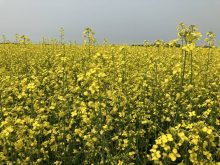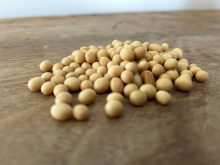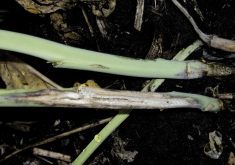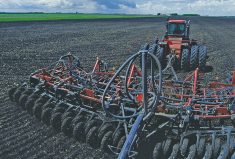As clubroot continues to spread across Alberta, many counties are in the management — not a prevention — phase.
Cody McIntosh, agricultural manager for Red Deer County, said the county inspected 140 fields this year.
“We confirmed another five fields (with clubroot), which is kind of the trend that everybody is seeing,” he said. “We were all assuming that with the dry growing conditions this year it would have been a lot slower and we wouldn’t have seen as much, but I don’t know if there’s just more clubroot around, or if it had to do with wet seeding conditions last year or even the wet harvest in 2016,” he said.
Read Also

New crop insurer policy enables easier startup for faba beans
Agriculture Financial Services Corporation updated its normals for faba beans, which may open the door for more Canadian producers to feel comfortable growing the pulse crop in the future.
Last month, clubroot was found in Rocky View County for the first time ever, the Canola Council of Canada recently reported.
“This fall, southern Alberta canola growers should be especially diligent in scouting their canola fields for clubroot,” the council said in its Canola Watch newsletter.
Red Deer County continues to educate landowners, even though most in the area know about the threat posed by clubroot, said McIntosh.
“Maybe they haven’t been directly impacted but somebody close to them has — a neighbour or someone down the road,” he said. “We’re in the management phase now, and that’s the message we need to get to our landowners.”
Red Deer County has had a policy since 2011 that prohibits growing canola for five years on a field where clubroot has been found. Many counties place similarly strict restrictions on fields known to be infected with clubroot spores.

Spores can survive in soil for up to 20 years, however, many “appear to become inactive or non-viable after a two-year break,” according to the Canola Council of Canada, which recommends a minimum two-year break and “much longer periods” for severe infestations.
The approach in Red Deer County is not to be as heavy handed, said McIntosh. Once clubroot is identified in a field, an agricultural team from the county takes 100 samples. They walk ‘W’ patterns and pull plants out at 20-metre intervals to determine the severity of infestation.
“If we determine it’s five per cent or higher, then that’s justification, we can prevent the growth of canola for five years now,” said McIntosh. “It can be three years if it’s a low level or moderate. It kind of varies.”
If the level of clubroot in the field is under five per cent, the agricultural team checks on the field every spring to ensure the producer is following a proper rotation and managing the field properly.
“It’s all that shift from early detection and prevention to managing,” he said. “Places like Leduc have managed the disease for seven to eight years. In other parts of the province, they’re still in that detection (phase).”
The agricultural field team always involves the farmer in the process, showing him or her the galls when they pull the plants. Farmers are advised to go out and look at more of their own fields, especially at swathing or harvest.
“Pull some stubble, pull it up and see what we’re looking for. We’ve used it as a tool to educate them, but also to get their buy-in,” said McIntosh.
“They don’t resist, they don’t challenge. They understand it’s there and we’re trying to give them some management practices to keep them growing canola, not prevent them from growing canola. It has a lot to do with approach, I think.”
McIntosh also advocates small changes, such as using a new entryway to the field.
In the County of Saint Paul, officials surveyed 600 fields and found 14 new cases, said agricultural fieldman Keith Kornelsen.
Last year, they found 30 infested fields.
“This year they were all compliant,” said Kornelsen. “There is a push (from some farmers) to drop the rotation and have it out of canola for (only) two years. Some farmers want that, but there is no data to suggest we should do that yet.”
Currently, producers in the County of Saint Paul have to take a clubroot-infested field out of rotation for at least three years.
Some of the clubroot-infested fields were not seeded to clubroot-resistant varieties.
“I think a lot of farmers have moved to resistant varieties, but we’re trying to get farmers to do that before we find it, so we don’t find it,” he said.
Dan Orchard, an agronomy specialist with the Canola Council of Canada, said that not all stats for clubroot detection have come in yet.
“I do know that a lot of counties are looking a lot harder right now,” said Orchard, who is based in Wetaskiwin and focuses on central Alberta. “They’re looking at more fields than ever before. I think that will lead to more findings.”
Many counties are reporting finding clubroot galls on resistant canola varieties within the area (from north of Barrhead and Westlock all the way south to Red Deer) where clubroot has been long established.
“There are new pathotypes appearing in the already affected regions, so it’s not a huge surprise,” said Orchard. “But most of these people, if not all of them, are on their second or third canola crop with resistance. And that’s when we expect when the pathotypes will appear.”
The length of time that a producer is prohibited from growing canola varies by county.
“It’s sometimes good, sometimes bad,” said Orchard. “It’s nice that the counties can work with the farmers and they’re not forced to do something. But in other ways, it’s not always the best because farmers aren’t always convinced that the counties have the knowledge to make that decision for them on how often they can grow canola.”
It would be best if the counties followed best management practices laid out by the Canola Council of Canada and other research partners, he said.
He also said that it’s important for growers all over the Prairies to pay a little more attention about moving soil around, particularly on equipment.
“Excessive tillage is always a culprit for fields that have major infestations,” he said. “If you have heavy tillage and you have resistant varieties showing up in patches, it’s really highly advised that you don’t move any soil around to other fields, or even within that field.”
















